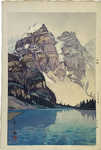| | |
| Artist: | Yoshida Hiroshi (1876-1950) — 吉田博 |
| Title: | Lake Moraine — モレーン湖 |
| Series: | North America Series — アメリカの部 |
| Date of first edition?: | 1926 |
| Publisher (first edition)?: | Yoshida Studio |
| Publisher (this edition)?: | Yoshida Studio |
| Medium (first edition): | Woodblock |
| Medium (this edition): | Woodblock |
| Format (first edition): | Oban
|
| Format (this edition): | Oban |
| DB artwork code: | 47192 |
| Notes (first edition)?: |
Hiroshi Yoshida, 1876-1950
The United States Series: Lake Moraine
(Beikoku shirizu: Morrenko)
吉田博
『 モレーン湖 』
大正14年
木版画
Signed in sumi ink, Yoshida, with artist's flower-shaped seal, and early editions have the artist's jizuri ('self-printed') seal at upper right. Dated in the mid-right margin, Taisho juyonen saku [1925]) followed by the print title, pencil title and signature on the bottom margin early editions (stamped on later editions), Moraine Lake, Hiroshi Yoshida
oban tate-e 6 3/8 by 11 in., 41.5 by 28 cm.
Reference:
Ogura, Yoshida Hiroshi zenhangashu (The Complete Woodblock Prints of Hiroshi Yoshida), Abe Shuppan, Tokyo, 1987, p. 41, no. 14 |
|
| Notes (this edition)?: |
| The following information was taken from the original web listing of this artwork. Note that there may be some inaccuracies:
吉田博 『 モレーン湖 』 真作 大正14年 木版画
吉田博 『 モレーン湖 』 真作 大正14年 木版画 数ある中から当ページをご覧いただき誠にありがとうございます。
こちらは吉田博の
大正14年作『 モレーン湖 』 、真作になります。
寸法
縦 39.3cm
横 27.5cm
摺面
縦 36.7cm
横 24.6cm
吉田博の真骨頂である風景画作品でございます。
裏面には鉛筆で筆跡がございますが消すことができます。
状態としては年代物なため経年劣化や日焼け、染み等もございますが、摺り面は鮮やかな色で満たされた綺麗な逸品でございます。
しかしながらあくまでも主観による判断になりますゆえ、ご自身で十分に画像をご確認いただきご納得した上で入札下さいますようお願い申し上げます。
また、画像の変色加工などは一切行っておりません。 (光の反射、 モニター環境などにより実物と色合いが若干異なる場合はございます)
ご不明な点が在りましたらお気軽にご質問下さい。当方の分かうる範囲ではございますが誠意をもって答えさせていただきます。
なかなか出て来ないお品です。 |
|
| Artist Bio: |
Yoshida Hiroshi (1876-1950)
This article is a review of the book The complete Woodblock Prints of Yoshida Hiroshi published by ABE Corporation, ISBN 4-87242-121-3.
Portrait of Yoshida Hiroshi
Yoshida Hiroshi is considered one of the leading figures of the renewal of Japanese printmaking after the end of the Meiji period (1912). The renewal was based on two groups of artists, the shin hanga (modern prints) and the sosaku hanga (creative prints) movement.
The Son of a School Principal
Yoshida Hiroshi was born as the son of an elementary school principal. His artistic talent was discovered early and at the age of 18 he entered a private art school in Tokyo.
Yoshida started as a painter and soon won many exibition prizes. But it was not before 1920 that he started creating woodblock prints. Yoshida Hiroshi then met Watanabe Shozaburo, publisher and owner of the Watanabe print store in Tokyo. Watanabe published the first seven of Yoshida Hiroshi's woodblock prints.
The Making of a Japanese Print
The Shalimar Gardens, 1932
The traditional process of creating a Japanese woodblock print was a cooperation of three strictly separated skills: the artist who designed the print subject, the carver and finally the printer and publisher. In contrast, the sosaku hanga followers believed that the process of creating a print - design, carving, printing - should be performed by the artist himself.
Although Yoshida is usally considered as a member of the shin hanga movement, he followed the same ambitions of creating a print by himself.
In 1923 Watanabe's store was completely destroyed in the fires that followed the great earthquake. All of Yoshida's woodblocks and more than a hundred of his prints were lost.
After coming back from his third visit to the United States, Yoshida in 1925 started employing his own artisan carvers and printers. He supervised them very closely and often he carved a block himself. He thought that he had to be more skilled in all aspects of producing a print than each of his workers.
Yoshida Hiroshi - an Avid Traveller
Kinoe, 1930
Yoshida travelled a lot. He came to the United States, Europe, Africa, India, China, Korea and througout Japan. Another passion was mountaineering. He even established an association called Nihon Sangakuga Kyokai, the Japan Alpine Artist Association. His prints reflect both his love for travelling and for mountains. Most of his prints show landscape scenes from his travels and mountain subjects from Japan and the European Alps.
Although his roots were in Japanese traditions, Yoshida was a real cosmopolitan artist who merged both worlds to something new and fascinating. When looking at his print scenes from abroad, you have the impression of being "on the spot". Yoshida is cited with the words "True art is cosmopolitan and the result therefore of external influences as well as of the inherent vitality and life of the different nations". Towards the end of his life, he planned a series entitled One Hundred Views of the World. Yoshida died before he could put his dream into reality.
At the end of his life, Yoshida Hiroshi had created 259 woodblock prints - seven published by Watanabe and the rest by Yoshida himself. It should not be forgotten that he gave the world even more than his own works of art: His both sons, Toshi and Hodaka Yoshida became great artists themselves.
The 1985 Commemorative Collection edition (西集記念)
From http://www.shogungallery.com/wwwboard/archive/oldmess/17.html :
In 1985, to celebrate a major exhibition of Hiroshi Yoshida's prints in Japan, Hiroshi's son, Toshi (an artist in his own right) published a number of his father's prints in commemoration, from the original blocks. These prints were of very high quality and according to Toshi limited to 300 impressions.
|
|











